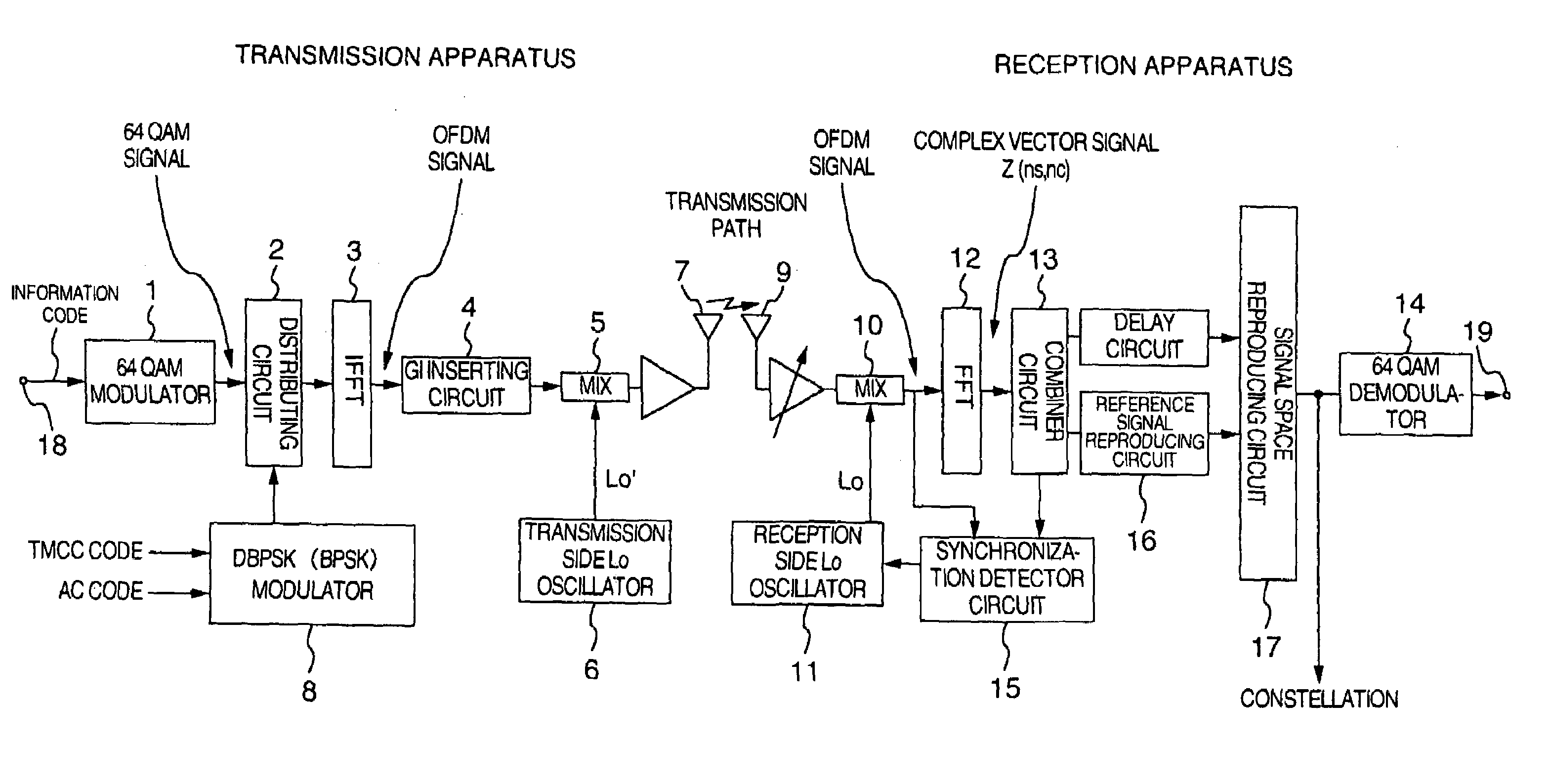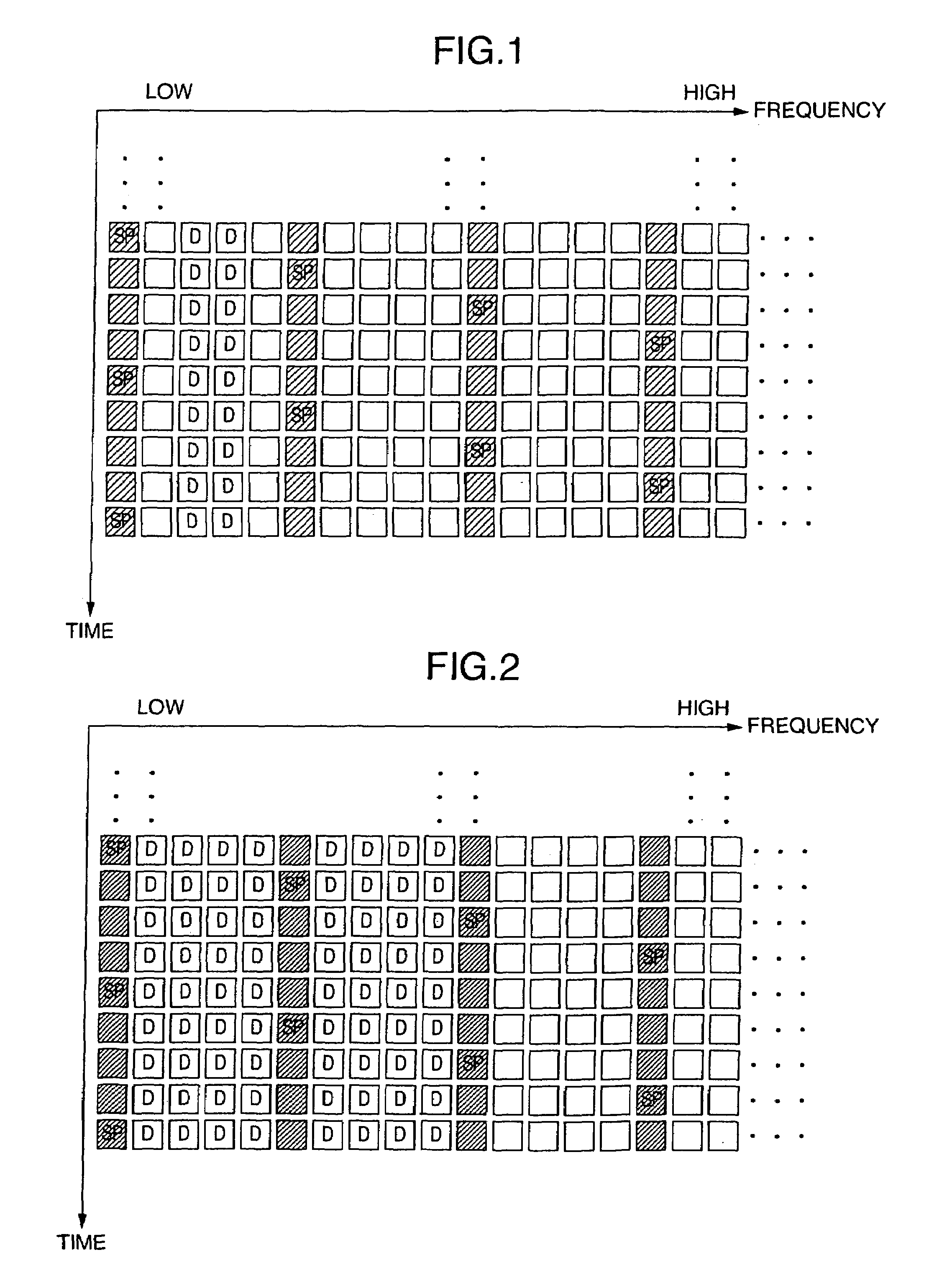Signal transmission/reception system of orthogonal frequency division multiplexing
a signal transmission and reception system technology, applied in the field of signal transmission/reception system of orthogonal frequency division multiplexing, to achieve the effect of large distortion, less susceptible, and high error correction performan
- Summary
- Abstract
- Description
- Claims
- Application Information
AI Technical Summary
Benefits of technology
Problems solved by technology
Method used
Image
Examples
first embodiment
[0072]FIG. 1 shows an exemplary structure of carriers in the present invention, wherein the horizontal direction represents the frequency, and the vertical direction represents the lapse of time, as is the case with FIG. 7. Squares “□” arrayed in the horizontal and vertical directions each represent one carrier. Thus, one row of carriers “□” arranged in the laterial direction represents one symbol which forms part of an OFDM signal.
[0073]Further, a carrier “□” with “SP” denoted within the square represents the position of a carrier for a pilot signal which is used for reproducing a reference signal during demodulation, while a carrier without any notation within the square represents the position of a carrier for a signal modulated in accordance with the 64 QAM scheme, also as is the case with FIG. 7.
[0074]The interval between SP carriers in the first embodiment of FIG. 1 may be any arbitrary number of columns of carriers, including three, as in the terrestrial digital broadcasting ...
second embodiment
[0089]From the foregoing, particularly largely distorted carriers are removed from C-carriers modulated in accordance with a synchronous modulation scheme with a higher number of multilevel, susceptible to noise and distortions in reference signal vectors, and mapped to D-carriers, likewise in the Consequently, as compared with the prior art which includes information codes decoded from carriers using largely distorted reference signal vectors, this embodiment can reduce a code error rate of information codes decoded from C-carriers modulated in accordance with the synchronous modulation scheme.
[0090]Also, in the second embodiment, the D-carriers are modulated in accordance with a synchronous modulation scheme with a lower number of multilevel, relatively immune to noise and distortions in reference signal vectors, even if this is the same synchronous modulation scheme as that used for modulating C-carriers. Therefore, a large distortion in a reference signal vector for this carrie...
third embodiment
[0106]In a specific implementation of the third embodiment, for example, as illustrated in FIG. 5, the error correction coding circuit 50 associated with information codes transmitted by C-carriers uses a ¾ convolutional code for the error correction code, while the error correction coding circuit 52 associated with an AC code transmitted by a D-carrier uses a ½ convolutional code, which has higher error correcting performance than the ¾ convolutional code for use with the information codes transmitted by the C-carriers, for the error correction code.
[0107]Though not particularly noted in the foregoing description, the value of the predetermined number M for defining the width of a boundary region of ends of the signal transmission band may be determined from an S / N (Signal to Noise) ratio for a distortion of the interpolation filter, and a C / N (Carrier to Noise) ratio which should be required in 64 QAM, assuming, for example, the modulation in accordance with 64 QAM, in which case ...
PUM
 Login to View More
Login to View More Abstract
Description
Claims
Application Information
 Login to View More
Login to View More - R&D
- Intellectual Property
- Life Sciences
- Materials
- Tech Scout
- Unparalleled Data Quality
- Higher Quality Content
- 60% Fewer Hallucinations
Browse by: Latest US Patents, China's latest patents, Technical Efficacy Thesaurus, Application Domain, Technology Topic, Popular Technical Reports.
© 2025 PatSnap. All rights reserved.Legal|Privacy policy|Modern Slavery Act Transparency Statement|Sitemap|About US| Contact US: help@patsnap.com



